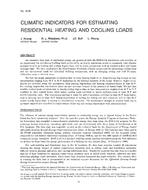Description
An extensive data base of residential energy use generated with the DOE-2.1. A simulation code provides us an opportunity for correlating building loads predicted by an hourly simulation model to commonly used climatic parameters such as heating and cooling degree-days, and to newer parameters such as insolation-days and latent enthalpy-days. We have emphasized the identification of reliable climatic parameters for estimating cooling loads and the incremental loads for individual building components, such as changing ceiling and wall R-values, infiltration rates or window areas.
We find the single parameter correlating best to total heating loads to be heating degree-days at base temperatures ranging from 56 F to 65 F depending on the thermal integrity of the house. However, higher correlations are obtained using two parameters daily heating degree-days and heating insolation-hours at base 65 F. For cooling, degree-day correlations alone are not accurate because of the presence of latent loads. We find that sensible cooling loads correlate best to hourly cooling degree-days at base temperatures ranging from 65 F to 71 F modified to omit vented hours, while latent cooling loads correlate to latent enthalpy-days at base 78 F and 0.0116 humidity ratio. The incremental savings in loads for added insulation correlate to base 65 F daily degree days in heating, but to base 75 F hourly degree-days in cooling for ceiling and wall measures, and to base 65 F vented hourly degree-days in cooling for foundations measures. The incremental changes in window loads due to increased window size correlate to combinations of heating and cooling degree-days with insolation-days.
Units: I-P
Citation: ASHRAE Transactions, 1987, vol. 93, pt. 1, New York, NY
Product Details
- Published:
- 1987
- Number of Pages:
- 40
- File Size:
- 1 file , 3.3 MB
- Product Code(s):
- D-NY-87-3018
